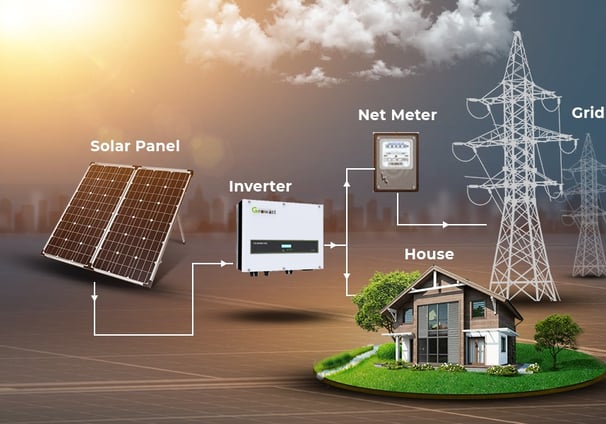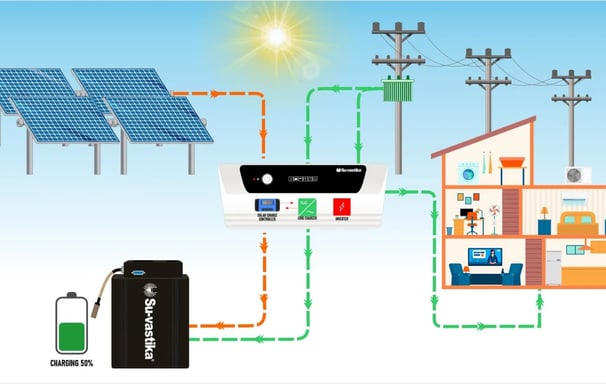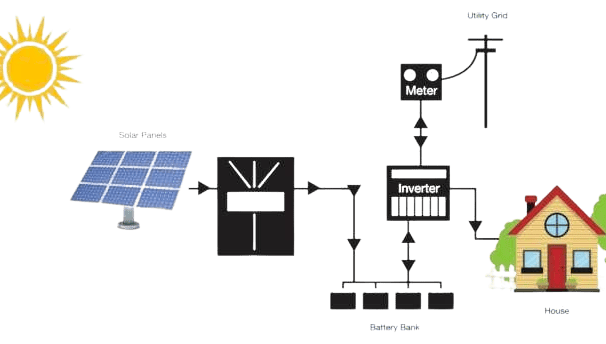Residential Solar
On-Grid Solar System
On-grid solar plants, also known as grid-tied or grid-connected solar systems, are renewable energy systems that generate electricity from sunlight and feed it into the utility grid. These systems are connected to the main electricity grid and do not require battery storage, as they use the grid as a storage mechanism.
Key Components of On-grid Solar Plants:
Solar Panels: Photovoltaic (PV) panels convert sunlight into electricity.
Inverter: Converts DC electricity generated by the solar panels into AC electricity, which can be used by household appliances and fed into the grid.
Grid Connection: A bi-directional meter records the electricity imported from and exported to the grid.
Benefits of On-grid Solar Plants:
Cost Savings: Reduces electricity bills by generating clean energy and potentially earning revenue through net metering.
Environmental Impact: Lowers carbon footprint by utilizing renewable energy sources.
Grid Stability: Helps stabilize the electricity grid by providing additional power during peak demand periods.
Government Incentives: Various government schemes and incentives promote the adoption of on-grid solar systems.


Key Components of Off-grid Solar Plants:
Solar Panels: Photovoltaic (PV) panels capture sunlight and convert it into electricity.
Charge Controller: Regulates the flow of electricity from the solar panels to the batteries, preventing overcharging and damage.
Battery Bank: Stores excess electricity generated during the day for use during periods of low sunlight or at night.
Inverter: Converts DC electricity stored in the batteries into AC electricity for powering appliances.
Backup Generator (optional): Sometimes, off-grid solar systems may include a backup generator fueled by diesel or other sources to provide additional power during extended periods of low sunlight.
Benefits of Off-grid Solar Plants:


Off-Grid Solar System
Off-grid solar plants, also known as standalone solar systems, are independent electricity generation systems that are not connected to the main electricity grid. These systems are designed to provide power in remote areas or locations where grid connection is not feasible or cost-effective. Off-grid solar plants typically incorporate solar panels, batteries for energy storage, and inverters to convert DC electricity into AC electricity for appliance use.
Hybrid Solar System
Off-grid solar plants, known as standalone solar systems, are independent electricity generation systems not connected to the main electricity grid. These systems are designed to provide power in remote areas or locations where grid connection is not feasible or cost-effective. Off-grid solar plants typically incorporate solar panels, batteries for energy storage, and inverters to convert DC electricity into AC electricity for appliance use
Key Components of Off-grid Solar Plants:
Solar Panels: Photovoltaic (PV) panels capture sunlight and convert it into electricity.
Charge Controller: Regulates the flow of electricity from the solar panels to the batteries, preventing overcharging and damage.
Battery Bank: Stores excess electricity generated during the day for use during periods of low sunlight or at night.
Inverter: Converts DC electricity stored in the batteries into AC electricity for powering appliances.
Backup Generator (optional): Sometimes, off-grid solar systems may include a backup generator fueled by diesel or other sources to provide additional power during extended periods of low sunlight.
Benefits of Off-grid Solar Plants:
Energy Independence: Provides electricity in areas with limited or unavailable grid access.
Environmental Sustainability: Reduces reliance on fossil fuels and minimizes carbon emissions.
Cost Savings: Eliminates the need for expensive grid infrastructure installation and ongoing electricity bills.
Reliability: Offers a reliable source of electricity, especially in remote or off-grid locations.
Disaster Resilience: Functions independently of the main grid, making it resilient to power outages caused by natural disasters or other emergencies.


